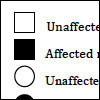Session Overview

|
This session will cover the background and assumptions that Mendel made regarding the inheritance of particular traits, the hypotheses he developed, the experiments he performed to test the hypotheses, and the conclusions he made. In addition, how offspring acquire genes (and thus traits) from parents by inheriting chromosomes, and how the movement of chromosomes during meiosis is related to Mendel’s rules of inheritance will be emphasized. Learning Objectives
|
Session Activities
Lecture Video
Watch the lecture video excerpt
Check Yourself
You are working with the following pea plants:
- Plant 1: Purple flowers
- Plant 2: Purple flowers
- Plant 3: White flowers
You set up three mating experiments using these plants and obtain the following results:
| Ratio of plants with following Phenotype | ||
|---|---|---|
| Experiment | Purple flowers | White flowers |
| #1: P1 with P2 | 100 | 0 |
| #2: P1 with P3 | 100 | 0 |
| #3: P2 with P3 | 50 | 50 |
Question 1
Which phenotype is dominant?
Experiment #2 demonstrates that purple flower color is dominant to white flower color.
Question 2
What is the genotype of Plant 1 with respect to flower color?
Question 3
What is the genotype of Plant 2 with respect to flower color?
Question 4
What is the genotype of Plant 3 with respect to flower color?
Session Activities
Lecture Video
Watch the lecture video excerpt
Check Yourself
You are studying two true-breeding varieties of plants. Flower size is controlled by the A gene and flower color is controlled by the B gene.
Parent 1: small yellow flowers
Parent 2: large red flowers
Question 1
You cross the two true-breeding parental plants, and find that **all** the F1 progeny have small red flowers. Which of the following phenotypes are dominant?
Question 2
You cross the two true-breeding parental plants, and find that **all** the F1 progeny have small red flowers. What is the genotype of Parent 1 with respect to flower color and size? Use A and B for the dominant traits, a and b for the recessive traits.
Question 3
You cross the two true-breeding parental plants, and find that **all** the F1 progeny have small red flowers. What is the genotype of Parent 2 with respect to flower color and size? Use A and B for the dominant traits, a and b for the recessive traits.
Question 4
You cross the two true-breeding parental plants, and find that **all** the F1 progeny have small red flowers. What is the genotype of F1 progeny with respect to flower color and size? Use A and B for the dominant traits, a and b for the recessive traits.
Question 5
You cross an F1 plant with a true breeding plant that has large yellow flowers and obtain 1000 progeny. Assume that the two genes assort independently. The progeny from this cross could show how many different phenotypes?
Question 6
You cross an F1 plant with a true breeding plant that has large yellow flowers and obtain 1000 progeny. Assume that the two genes assort independently. Of the 1600 progeny plants, approximately how many would be expected to have large yellow flowers?
Session Activities
Practice Problems
Further Study
Study Guides
Suggested topics for further study in an introductory-level Biology textbook
- Mendel’s laws of inheritance
- Common genetic terms
- Genetic crosses
- Punnett Squares
- Meiosis, and its relationship to Mendelian inheritance and Punnett Squares.










